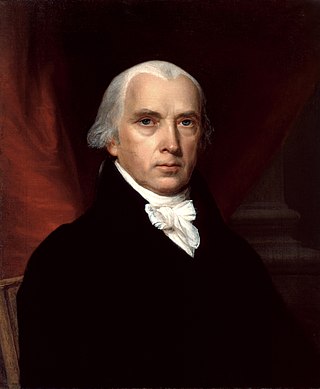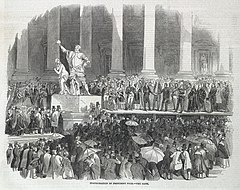
James Knox Polk was the 11th president of the United States, serving from 1845 to 1849. Before he became president, Polk served as the 13th speaker of the House of Representatives (1835–1839) and ninth governor of Tennessee (1839–1841). A protégé of Andrew Jackson, he was a member of the Democratic Party and an advocate of Jacksonian democracy. Polk is known for extending the territory of the United States through the Mexican–American War; during his presidency, the U.S. expanded significantly, annexing the Republic of Texas, the Oregon Territory, and the Mexican Cession after winning the Mexican–American War.

Between 73 and 79 days after the presidential election, the president-elect of the United States is inaugurated as president by taking the presidential oath of office. The inauguration takes place for each new presidential term, even if the president is continuing in office for a second term.

The presidency of James K. Polk began on March 4, 1845, when James K. Polk was inaugurated as President of the United States, and ended on March 4, 1849. He was a Democrat, and assumed office after defeating Whig Henry Clay in the 1844 presidential election. Polk left office after one term, fulfilling a campaign pledge he made in 1844, and he was succeeded by Whig Zachary Taylor. A close ally of Andrew Jackson, Polk's presidency reflected his adherence to the ideals of Jacksonian democracy and manifest destiny.

The first inauguration of George W. Bush as the 43rd president of the United States took place on Saturday, January 20, 2001, at the West Front of the United States Capitol in Washington, D.C. This was the 54th inauguration and marked the commencement of the first term of George W. Bush as president and Dick Cheney as vice president. Chief Justice William Rehnquist administered the presidential oath of office at 12:01 p.m., after he administered the vice presidential oath of office as well. An estimated 300,000 people attended the swearing-in ceremony. This was the first presidential inauguration to take place in the 21st century, and the first in the 3rd millennium.

The second inauguration of Bill Clinton as president of the United States was held on Monday, January 20, 1997, at the West Front of the United States Capitol Building in Washington, D.C. This was the 53rd inauguration and marked the commencement of the second and final term of Bill Clinton as president and Al Gore as vice president. This was the last presidential inauguration to take place in the 20th century, the last in the 2nd millennium, and the first to be streamed live on the internet.

The second inauguration of Ronald Reagan as president of the United States was held in a televised ceremony on January 20, 1985, at the White House, and was repeated the following day, January 21, 1985, at the Capitol's rotunda. This was the 50th presidential inauguration and marked the commencement of the second and final four-year term of both Ronald Reagan as president and of George H. W. Bush as vice president. At 73 years, 349 days of age on Inauguration Day, Reagan was the oldest U.S. president to be inaugurated, until Joe Biden's inauguration as president on January 20, 2021, at the age of 78 years, 61 days.

The inauguration of Jimmy Carter as the 39th president of the United States was held on Thursday, January 20, 1977, at the East Portico of the United States Capitol in Washington D.C. This was the 48th inauguration and marked the commencement of Jimmy Carter's and Walter Mondale's single term as president and vice president. Chief Justice Warren E. Burger administered the presidential oath of office to Carter, and Speaker of the House Tip O'Neill administered the vice presidential oath of office to Mondale. This was the last inauguration held on the East Portico of the Capitol building as well as the last time the chief justice would stand to the left of the podium, with the audience facing them, while swearing in a president. Exactly forty years later, Carter attended the inauguration of Donald Trump, becoming the first U.S. president to mark the 40th anniversary of his inauguration.

The second inauguration of Richard Nixon as president of the United States was held on Saturday, January 20, 1973, at the East Portico of the United States Capitol in Washington, D.C. This was the 47th inauguration and marked the commencement of the second and final term of both Richard Nixon as president and Spiro Agnew as vice president. Both Agnew and Nixon resigned within two years of this term. In December 1973, Gerald Ford replaced Agnew as vice president and in the following year, replaced Nixon as president. This made Nixon the first and, as of 2023, only person to be inaugurated four times as both president and vice president. Chief Justice Warren E. Burger administered both the presidential and vice presidential oaths of office. During the ceremony, Look With Pride On Our Flag, a song dedicated to President Nixon and composed by Hank Fort, was played.

The first inauguration of Richard Nixon as the 37th president of the United States was held on Monday, January 20, 1969, at the East Portico of the United States Capitol in Washington, D.C. This was the 46th inauguration and marked the commencement of the first and eventually only full term of both Richard Nixon as president and Spiro Agnew as vice president. Chief Justice Earl Warren administered the presidential oath of office to Nixon, and Senate Minority Leader Everett Dirksen administered the vice presidential oath to Agnew. Nixon was the first non-incumbent vice president to be inaugurated as president. This was also the last presidential oath administered by Chief Justice Warren.

The second inauguration of Lyndon B. Johnson as president of the United States was held on Wednesday, January 20, 1965, at the East Portico of the United States Capitol in Washington, D.C. This was the 45th inauguration and marked the second and only full term of Lyndon B. Johnson as president and the only term of Hubert Humphrey as vice president. Chief Justice Earl Warren administered the oath of office. Lady Bird Johnson founded the tradition of incoming first ladies participating in the ceremony by holding the sworn-in president's Bible. Vice President Humphrey was sworn-in by John W. McCormack, the speaker of the House of Representatives. This was the first inauguration when the president rode in a bulletproof limousine.

The first inauguration of James Madison as the fourth president of the United States was held on Saturday, March 4, 1809, in the chamber of the House of Representatives at the United States Capitol in Washington, D.C. The inauguration marked the commencement of the first four-year term of James Madison as president and the second term of George Clinton as vice president. The presidential oath was administered by Chief Justice John Marshall. The President wore a 100% American-made wool suit, and the first official inaugural ball occurred at Long's Hotel, with ticket prices being $4. Clinton died 3 years, 47 days into this term, and the office remained vacant for the balance of it. Clinton was the first vice president to die in office.

The second inauguration of James Madison as president of the United States was held on Thursday, March 4, 1813, at the United States Capitol in Washington, D.C. The inauguration marked the commencement of the second four-year term of James Madison as president and the only term of Elbridge Gerry as vice president. The presidential oath was administered by Chief Justice John Marshall. Gerry died 1 year, 264 days into this term, and the office remained vacant for the balance of it.

The second inauguration of James Monroe as president of the United States was held on Monday, March 5, 1821, in the House chamber of the U.S. Capitol. The inauguration marked the commencement of the second four-year term of James Monroe as president and Daniel D. Tompkins as vice president. Monroe had almost unanimously won the election of 1820 for a second term. He was sworn in by John Marshall, the Chief Justice of the United States.

The second inauguration of William McKinley as president of the United States was held on Monday, March 4, 1901, at the East Portico of the United States Capitol in Washington, D.C. This was the 29th inauguration and marked the commencement of the second and final term of William McKinley as president and the only term of Theodore Roosevelt as vice president. McKinley died 194 days into this term, and Roosevelt succeeded in the presidency.

The inauguration of Zachary Taylor as the 12th president of the United States was held on Monday, March 5, 1849, at the East Portico of the United States Capitol in Washington, D.C., and was the second instance of an inauguration being rescheduled due to March 4 falling on a Sunday, the Christian sabbath. This was the 16th regular inauguration and marked the commencement of the only four-year term of both Zachary Taylor as president and Millard Fillmore as vice president. Taylor died 1 year, 126 days into this term, and Fillmore succeeded to the presidency. The presidential oath of office was administered by Chief Justice Roger B. Taney. Inauguration Day started off being cloudy with snow flurries, but turned to heavy snow during the inaugural balls.

The inauguration of Franklin Pierce as the 14th president of the United States was held on Friday, March 4, 1853, at the East Portico of the United States Capitol in Washington, D.C. This was the 17th inauguration and marked the commencement of the only four-year term of both Franklin Pierce as president and William R. King as vice president. Chief Justice Roger B. Taney administered the presidential oath of office. Pierce affirmed the oath of office rather than swear it, and was also the first president to recite his inaugural address from memory.

The inauguration of James Buchanan as the 15th president of the United States was held on Wednesday, March 4, 1857, at the East Portico of the United States Capitol in Washington, D.C. This was the 18th inauguration and marked the commencement of the only four-year term of both James Buchanan as president and John C. Breckinridge as vice president. Chief Justice Roger B. Taney administered the presidential oath of office. This was the first inauguration ceremony known to be photographed.

The inauguration of James A. Garfield as the 20th president of the United States was held on Friday, March 4, 1881, at the East Portico of the United States Capitol in Washington, D.C. This was the 24th inauguration and marked the commencement of the only four-year term of James A. Garfield as president and Chester A. Arthur as vice president. Garfield was assassinated 199 days into this term, and Arthur ascended to the presidency. Chief Justice Morrison Waite administered the presidential oath of office.

The first inauguration of Grover Cleveland as the 22nd president of the United States took place on Wednesday, March 4, 1885, at the East Portico of the United States Capitol in Washington, D.C. This was the 25th inauguration and marked the commencement of the first four-year term of Grover Cleveland as president and the only term of Thomas A. Hendricks as vice president. Hendricks died 266 days into this term, and the office remained vacant since there was no constitutional provision which allow an intra-term vice-presidential office filling; it would be regulated by the Twenty-fifth Amendment in 1967.

The first inauguration of Woodrow Wilson as the 28th president of the United States was held on Tuesday, March 4, 1913, at the East Portico of the United States Capitol in Washington, D.C. This was the 32nd inauguration and marked the commencement of the first four-year term of Woodrow Wilson as president and Thomas R. Marshall as vice president. Chief Justice Edward D. White administered the presidential oath of office to Wilson.





















